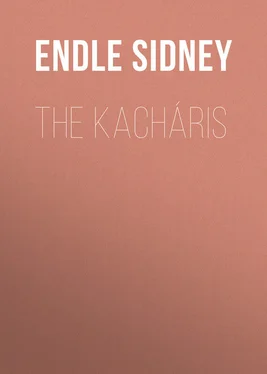Sidney Endle - The Kacháris
Здесь есть возможность читать онлайн «Sidney Endle - The Kacháris» — ознакомительный отрывок электронной книги совершенно бесплатно, а после прочтения отрывка купить полную версию. В некоторых случаях можно слушать аудио, скачать через торрент в формате fb2 и присутствует краткое содержание. Жанр: foreign_antique, foreign_prose, на английском языке. Описание произведения, (предисловие) а так же отзывы посетителей доступны на портале библиотеки ЛибКат.
- Название:The Kacháris
- Автор:
- Жанр:
- Год:неизвестен
- ISBN:нет данных
- Рейтинг книги:5 / 5. Голосов: 1
-
Избранное:Добавить в избранное
- Отзывы:
-
Ваша оценка:
- 100
- 1
- 2
- 3
- 4
- 5
The Kacháris: краткое содержание, описание и аннотация
Предлагаем к чтению аннотацию, описание, краткое содержание или предисловие (зависит от того, что написал сам автор книги «The Kacháris»). Если вы не нашли необходимую информацию о книге — напишите в комментариях, мы постараемся отыскать её.
The Kacháris — читать онлайн ознакомительный отрывок
Ниже представлен текст книги, разбитый по страницам. Система сохранения места последней прочитанной страницы, позволяет с удобством читать онлайн бесплатно книгу «The Kacháris», без необходимости каждый раз заново искать на чём Вы остановились. Поставьте закладку, и сможете в любой момент перейти на страницу, на которой закончили чтение.
Интервал:
Закладка:
Final Separation of Northern and Southern V. It may perhaps be asked how a people so clannish and united as the Kacháris are well known to be, should ever become so widely separated as the Western (Bara) and Southern (Dimásá) sections now undoubtedly are. The separation would seem to be almost final and complete. The writer, e. g. , has often tried Sections of the race. to ascertain if the Kacháris of the Northern Duars retained any tradition of ever having been subject to the Raja of Dimápur; but up to the present time no trace of any such tradition has come to light. Intermarriage between the two sections of the race is apparently quite unknown; indeed, the barrier of language would of itself probably go far to prevent such intermarriage: for although the two languages have much in common, yet in their modern form they differ from each other nearly as much as Italian does from Spanish; and members of the two sections of the race meeting each other for the first time would almost certainly fail to understand each other’s speech. Perhaps the following tradition, 4 4 Extracted from a most interesting and valuable letter from Mr. Dundas, kindly forwarded for perusal to the writer by B. C. Allen, Esq., I.C.S.
which apparently describes one of the closing scenes in the prolonged struggle between the Chutiyá Kacháris and the Ahoms, may go some way to account for the wide separation between the Northern and Southern sections of the race. The story is as follows: – Long, long ago the Dimásá fought against a very powerful tribe (the Ahoms), and being beaten in a great pitched battle, the king with all his forces retreated. But presently further retreat was barred by a wide and deep river, which could in no way be crossed. The Raja, being thus stopped by a river in front and an enemy behind, resolved to fight once more the next day, unless the problem of crossing the river could be solved. With this determination he went to sleep and had a dream in which a god appeared to him and promised to help him. The god said that early next morning the king with all his people must boldly enter the river at a spot where he would see a heron standing in the water, and walk straight across the river, but no one must look back. Next morning a heron was found, sure enough, standing in the water near the bank; and the king, remembering his dream, led his people to the spot and went into the water, which they found had shoaled enough to form a ford and allow them to wade across. In this way he crossed with a great part of his people. But still all had not crossed. There were some on the other bank and some in the middle of the river, when a man among the latter wondering whether his son was following him, looked back, with the result that the water at once got deep and every one had to save himself as best he could; while the men on the other bank, having no chance of crossing, dispersed. They who were caught in the middle of the river had to swim for their lives, and were washed down to different places. Some saved themselves by catching hold of Khágris (rushes) growing on the bank, and are to this day called Khágrábária . Others caught hold of nals (or reeds) and are thus called Nalbárias. The Dimásá are the people who crossed in safety.
It is fairly obvious that the Oriental love for the grotesquely marvellous has had no small share in the development of this tradition; but whilst making all due allowance for this, the writer ventures to think that the tradition itself is not altogether without a certain historic value. It probably represents the closing scenes in the protracted struggle for supremacy between the Ahoms and the Chutiyás (Kacháris) when the latter, finally beaten, endeavoured to escape their foes by crossing the Brahmaputra to the South bank, using for that purpose whatever material was at hand, e. g. , rude dug-out boats ( khel náu ), extemporised rafts ( bhel ), &c. The student of Assam history will remember that a like mishap befell Mir Jumla’s expedition for the conquest of Assam; Rangpur, Ghergaon, &c., when a violent storm or sudden rise in the river carried away or sunk the boats containing his ammunition and other stores, and he was compelled to come to terms with the Ahom rulers. A sudden storm or rapid rise in the river may have prevented many of the fugitives from crossing, and these would perforce have fallen into the hands of the Ahoms. The latter, acting on the principle “Divide et impera,” may have forced their captives to take up their abode in the unhealthy (Terai) country now known as the “Kachári Duárs,” and further may have prohibited any communication between the two severed fragments of the conquered race, which would thenceforth naturally drift further asunder, until the separation became as complete as it remains to this day.
SECTION II
Social and Domestic Life
Dwellings, houses, &c. In their domestic life, the Kacháris of this district (Darrang) do not differ very materially from their Hindu neighbours, to the subordinate castes of whom they are no doubt very closely allied. The houses are of the usual type, one-storied only, the walls being of ekrá reed or of split bamboo, and the roof of thatch fastened by cane. Each hut commonly contains two rooms, one for eating, &c., and the other for sleeping. There is no trace here of the practice which prevails among some tribes of the Province who are undoubtedly very nearly related to the Kacháris, i. e. , the provision of bachelor-barracks ( Dekáchángs ), where all the young unmarried men of the village have to sleep apart from the dwellings of settled householders. It is probable, indeed, that this custom formerly obtained here, but all trace of it seems to have passed away long since.
Villages. A Kachári village is as a rule much more compact than a Hindu one, the houses being built more closely together. Usually, too, there is comparatively little foliage in the way of trees, &c.; and occasionally even something like a street separates the two or more lines of houses which compose a village. One prominent feature in the typical Kachári village cannot fail to strike the attention of any casual visitor at first sight. Each house, with its granary and other outbuildings, is surrounded by a ditch and fence, the latter usually made of ekrá reeds, jungle grass or split bamboo, &c. The ditch, some three or four feet in depth, surrounds the whole homestead, the earth taken from it being thrown up on the inner side, i. e. , that nearest to the dwelling-house; and on the earthworks, some two or three feet in height, so thrown up are firmly inserted the reeds or split-bamboo work forming the fence itself, this latter often inclining outwards at a very obtuse angle; so that the ditch and fence are not easily surmounted from the outside by would-be intruders. A Kachári village usually abounds in domestic live-stock of various kinds, e. g. , ducks, fowls, goats, pigs, cattle, &c.; and it can hardly be doubted that the fence and ditch above spoken of are largely intended to prevent the cattle, pigs, &c., from getting into the rice-fields at night, and so doing serious damage to the paddy and other crops. With the abundance of live-stock, especially hogs, reared and kept by the Kacháris, it need hardly be said that the villages can scarcely be described as being cleanly; though as a rule they do not differ so much as might be supposed in this respect from their Hindu neighbours, separate buildings being provided for the pigs, goats, &c., at an appreciable distance from the family dwelling-house.
Little need be said under this head, as the equipment of the Kachári householder for dealing with domestic or field work is almost identical with that of his Hindu neighbours. But it may be stated that in a Kachári house there will usually be found an exceptionally large number of earthenware vessels (pottery, &c.) which are used freely and frequently in the preparation and distribution of the much-prized rice-beer ( Zu ).
Читать дальшеИнтервал:
Закладка:
Похожие книги на «The Kacháris»
Представляем Вашему вниманию похожие книги на «The Kacháris» списком для выбора. Мы отобрали схожую по названию и смыслу литературу в надежде предоставить читателям больше вариантов отыскать новые, интересные, ещё непрочитанные произведения.
Обсуждение, отзывы о книге «The Kacháris» и просто собственные мнения читателей. Оставьте ваши комментарии, напишите, что Вы думаете о произведении, его смысле или главных героях. Укажите что конкретно понравилось, а что нет, и почему Вы так считаете.











